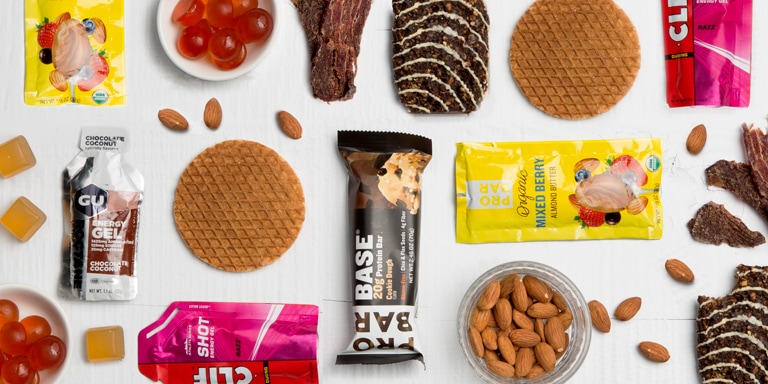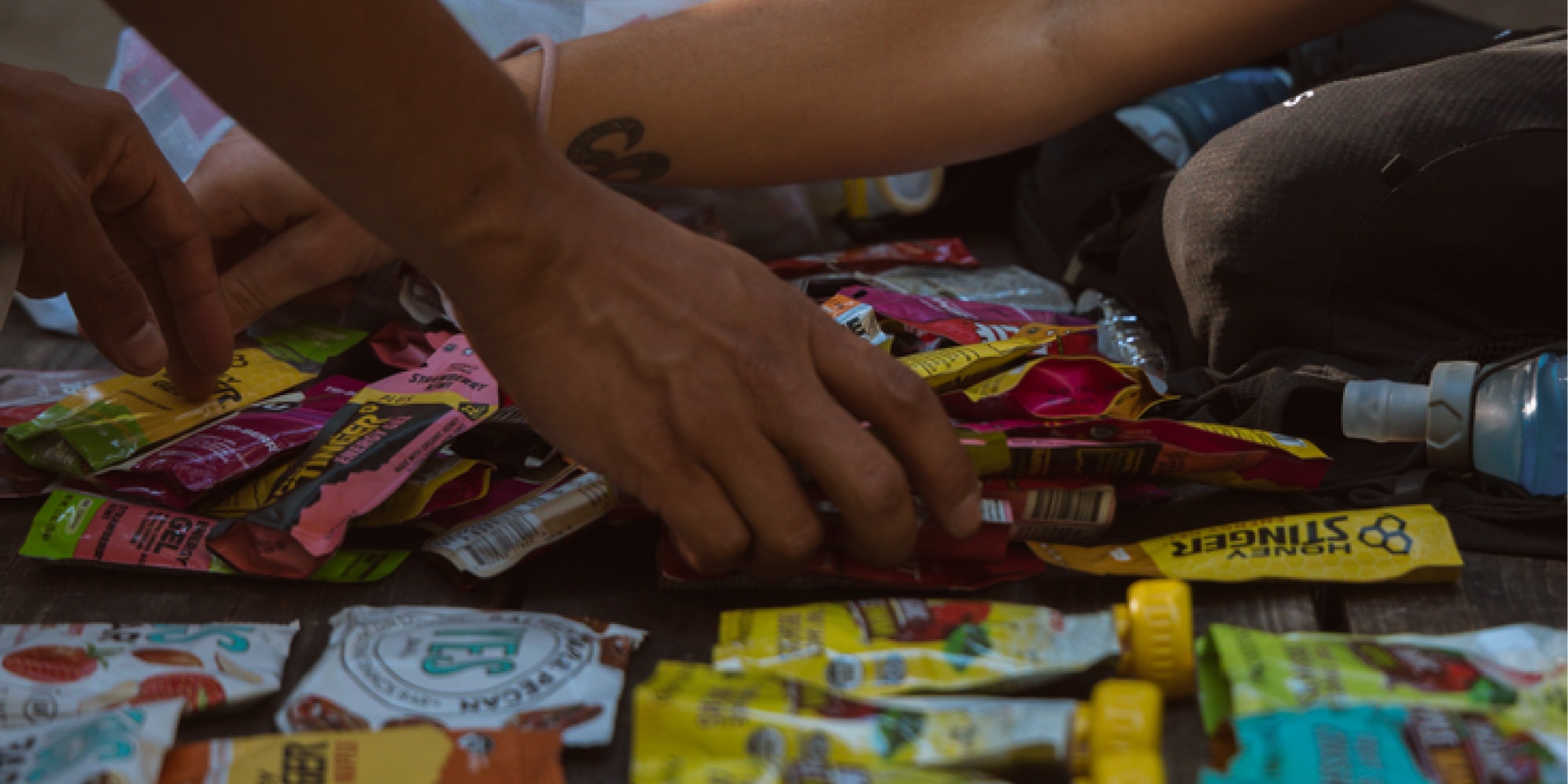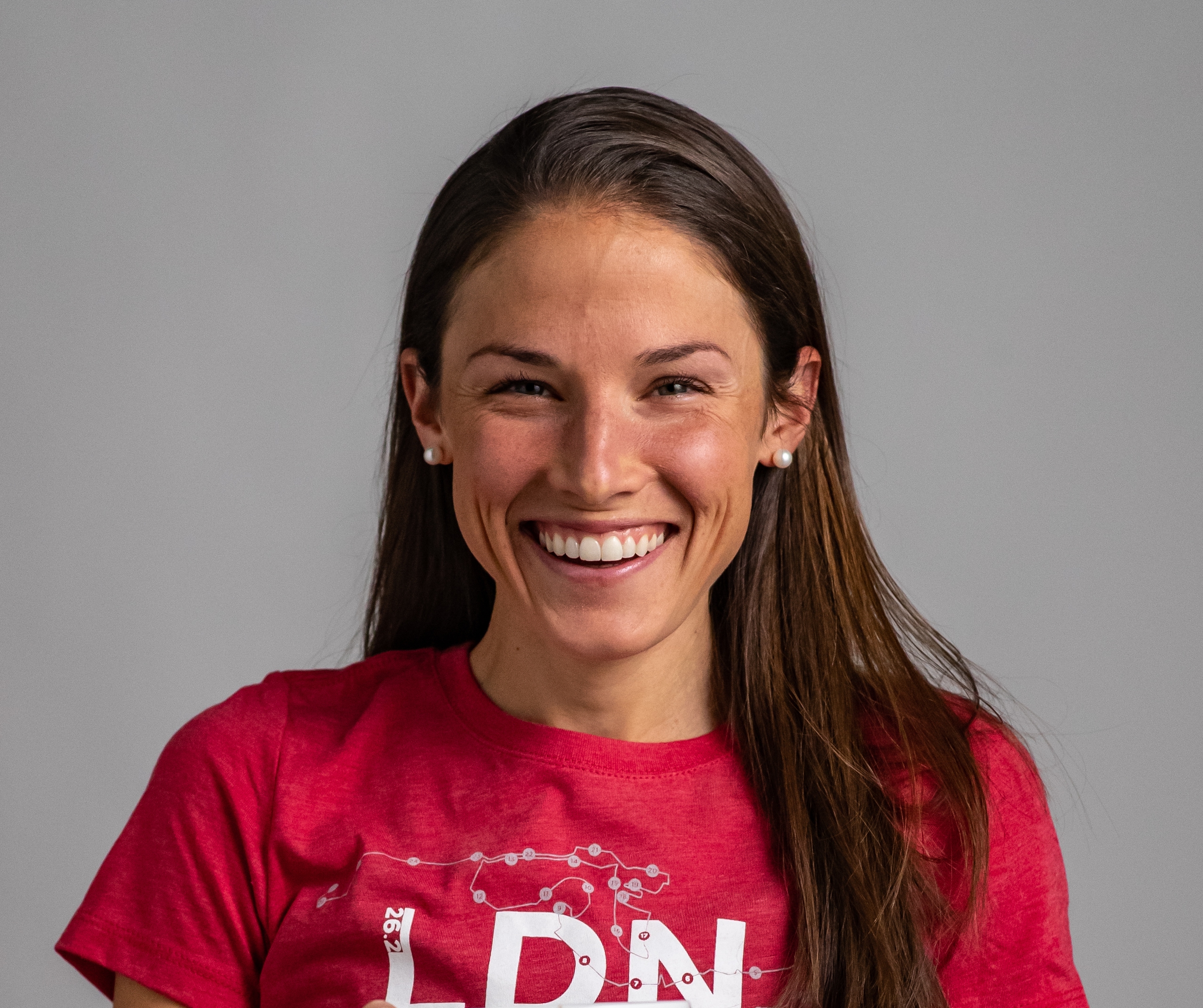Becoming a faster, stronger and more durable runner isn't just about the miles, the splits or the vert. It's also about what you do to support your training during your downtime: prioritizing sleep, keeping an eye on the lifespan of your shoes, tending to unusual aches and pains right away, working on your mental game, improving your strength and mobility and more.
Nutrition is one of those pillars that can't be neglected without consequence but that can be confusing to navigate. What should you eat the night before a long run? What about during the run itself? Do you even need to eat or drink on the run if you've fueled well beforehand? Your speedy training partner swears by intermittent fasting—should you try it, too?
This article aims to simplify the topic of nutrition for runners of all types, allowing you to fuel optimally for whatever adventures or competitions lie ahead. The advice below is rooted in research, with input from three experts: Claire Shorenstein, a registered dietitian, board-certified sports dietitian, and the host of the Eat for Endurance podcast; Stephanie Miezen, a registered dietitian, certified specialist in sports dietetics, and the owner of Cook Eat Compete; and Kristy Baumann, a registered dietitian who works primarily with runners and is known on social media as the Marathon Nutritionist. The information is presented in four sections:
- Nutrition Basics: Understand the role that carbohydrates, protein and fat play in both your running and daily living.
- Fueling Plan: Learn what types of food are best for pre-run, mid-run and post-run, and how to build a plan accordingly.
- Common Pitfalls: Identify some of the common nutrition- and hydration-related issues that runners face so you can do your best to avoid them.
- General Nutrition Tips: Get general fueling advice from three experts with a wealth of education and experience in the endurance space.
Understand Nutrition Basics

The first step towards optimizing your fueling is understanding some key nutrition terms and principles.
In simple terms, calories refer to the energy you derive from everything you eat and drink. While calories offer a broad overview of your diet, they don't tell the whole story.
Calories can be broken down into macronutrients (commonly called "macros"), which include carbohydrates, proteins and fats.
- Carbohydrates are called "the master fuel" for good reason. They're the energy source you can break down and metabolize most efficiently. At around 60-70% of your maximum effort, Miezen explains, your body primarily draws on carbohydrates for fuel. For distances longer than a sprint (generally speaking, a half mile and above), your body will heavily rely on carbs. High-quality carbohydrate sources include fruits, whole grains, beans and starchy vegetables such as corn, peas and potatoes.
- Fats are the main fuel source during light- to moderate-intensity exercise, such as walking and cycling with low resistance. During this type of exercise, you elevate your heart rate from baseline but can still carry on a conversation. According to Miezen, fats also aid in the absorption of vitamins, support hormone production and increase satiety. Nutritious fat sources include nuts and nut butters, seeds, olive oil, vegetable oils, avocado and oily fish.
- Proteins, while not a primary fuel source, are important for athletes because they promote muscle growth and tissue repair. Miezen says that proteins also help slow the digestion of carbohydrates to "extend" their energy release, an especially important function for ultra runners (those covering distances longer than 26.2 miles). Foods high in protein include lean and oily fish, eggs, lower-fat dairy, chicken, turkey, lean cuts of beef and pork, and soy foods like tofu and edamame.
Create a Fueling Plan
Once you've reviewed the basics, you can put them into action and make a plan. Since the goal is to fuel in a way that supports your running aspirations, it may be helpful to think about your nutrition in terms of pre-run, mid-run and post-run periods. Here are some guidelines compiled from Shorenstein, Miezen and Baumann that will help you frame your food choices around a run or race.
Keep in mind that context is important and everyone's fueling needs are unique. (You can consult a registered sports dietician to design a plan specific to you.) In addition to training regimen, several other factors influence your nutritional needs. Baumann says that list includes body size, age, gender, sweat rate and composition, climate, environment, fitness level, and pace. But ultimately, she emphasizes, a good plan is a sustainable one; your palate, access to foods, time to shop and prepare meals, cooking skills, and nutritional knowledge matter, too.

Pre-Run: The Night Before a Long Run or Race
The night before a long effort, aim for a balanced dinner with roughly 50% carbs, 25% protein, 25% fruits and vegetables. Limit your consumption of foods that are high in fat and fiber, which may cause stomach issues during your run. Add salt to your food and/or drink an electrolyte beverage for sufficient hydration.
Examples: Miezen's dinner ideas include chicken tacos with corn tortillas, avocado and salsa; tofu and veggie stir-fry with rice; lean beef meatballs with pasta, tomato sauce, and side salad; grilled salmon and vegetables with couscous; and salmon sushi rolls with a side salad and edamame.
Pre-Run: The Morning of a Long Run or Race
Opt for simple, easily digestible carbohydrates to the tune of 50-90 grams before you start running; the longer the run, the more carbohydrates and time to digest you'll need pre-run. If you can tolerate it, add a little bit of protein, fat, and color (fruits and vegetables) to your plate. Allow yourself 2-4 hours to digest a full meal, and 30-60 minutes for a carbohydrate-rich snack. Don't forget to start hydrating as soon as you wake up.
Examples: For pre-run snacks, Baumann likes graham crackers, Pop Tarts, applesauce, sports drinks, fig bars, and bagels. For more substantial and balanced meals, Miezen suggests a bagel with peanut butter and strawberries; oatmeal with nuts, dried fruit and milk; and a rice bowl with scrambled eggs and vegetables.
Mid-Run: During Shorter Runs (an hour or less)
Our experts differ, however, on how long a run should be to warrant mid-run fueling. For Shorenstein, the range begins at 60-75 minutes. For Miezen, it starts at 45-60 minutes. Baumann's criterion isn't so much duration as effort; she recommends fueling during all hard workouts (i.e., anything other than an easy or recovery run) in order to maximize your effort, prepare for races and finish strong. Experiment to see what works best for you. For example, if you have trouble completing or recovering from 45-60-minute runs, you may want to fuel for them.
For runs shorter than those ranges, you may be fine without mid-run hydration or calories—especially if you've eaten a substantial carbohydrate-rich meal or snack beforehand and are well-hydrated going in—but you also may benefit from water, electrolytes, and/or carbohydrates, depending on the circumstances.
Mid-Run: During Longer Runs (one to several hours)
Once your runs hit 60-75-minutes, Shorenstein recommends taking in carbohydrates in quantities that depend on the duration of your run. If you'll be running less than 2.5-3 hours, 30-60 grams of carbohydrate per hour is a solid goal.
For runs longer than 2.5-3 hours, Shorenstein says to aim for 60-90 grams of carbohydrate per hour. Beyond that—once you enter the 4-5-hour and beyond territory of trail- and ultra-marathons—she says to consider adding a small amount of protein as well (around 5 grams per hour).
Examples: To meet your carbohydrate needs on the run, Baumann suggests a combination of energy chews, gels, candy, fruit snacks, dried fruit and other real food options. Both Baumann and Miezen also recommend carbohydrate-based sports drinks that include electrolytes, which ticks three boxes at once: carbohydrates, fluids and electrolytes.
Post-Run: Immediately After a Run or Race
If you can, start snacking within 30 minutes of finishing a run and eat a bigger, balanced meal 2 to 3 hours later. Your post-run focus should be on carbohydrates first and protein second. Carbohydrates help refuel muscle energy stores while protein stimulates muscle repair, both of which are important pieces of the recovery puzzle.
Examples: Some of Miezen's favorite recovery combinations include a sandwich with turkey, avocado and vegetables on whole grain bread; a smoothie with fruit, milk and nut butter; yogurt with fruit and granola; and pita and vegetables with hummus, plus a hard-boiled egg. Baumann recommends chocolate milk, drinkable yogurt, toast with banana and peanut butter, and sports bars with carbohydrates and protein.
Identify Potential Pitfalls
Unfortunately, even the perfect fueling plan won't make you immune to some of the serious nutritional issues that plague endurance athletes. Here are four of the most common ones:
Relative Energy Deficiency in Sport
Insufficient fueling can do more than hinder your performance. Active individuals who don't fuel adequately become susceptible to relative energy deficiency in sport (RED-S), "a syndrome of poor health and declining athletic performance that happens when athletes do not get enough fuel through food to support the energy demands of their daily lives and training." Shorenstein explains that RED-S encompasses the far-reaching effects that can occur when an athlete does not meet his or her body's energy demands. Warning signs include frequent stress fractures, irregular periods or loss of period, poor sleep, mood changes, constipation, low iron levels, and reduced performance.
To ensure you're meeting your energy demands, Shorenstein recommends prioritizing balanced meals and frequent snacking (at least every 3 to 4 hours); making sure you're fueling your workouts adequately (before, during and after); and understanding that hunger cues are not always a reliable source of information. For the data lovers out there, you can go one step further by testing your resting metabolic rate (RMR) to get a sense of your total energy needs. Although the test is traditionally done in medical settings, you can also purchase at-home RMR tests online. If you take an at-home test, you should share and discuss the results with a medical doctor.
Eating Disorders and Disordered Eating
Endurance athletes—who tend to train and race in minimal clothing and are often conditioned to believe that lighter equals faster—show an increased prevalence of eating disorders. Although they have a state of low energy availability in common, RED-S should not be confused with eating disorders or disordered eating. Eating disorders describe "behavioral conditions characterized by severe and persistent disturbance in eating behaviors and associated distressing thoughts and emotions" and include anorexia nervosa, bulimia nervosa, binge eating disorder and avoidant restrictive food intake disorder. Disordered eating occupies the space between normal eating and an eating disorder and may have some commonalities with eating disorders, but with less frequency or intensity. Types of disordered eating include dieting, restricting, binging, and irregular or inflexible eating habits.
(According to the National Eating Disorders Collaboration, an expert-informed initiative funded by the Australian government, dieting is among the strongest predictors for an eating disorder. Dieting, which involves a person signficantly reducing their food intake or exlcuding certain foods for non-moral, -religious or -allergy-based reasons, can lead to binge-restrict cycles. But the practice should not be confused with gradual and sustainable lifestyle changes designed by a registered dietician to help an individual eat a more balanced diet that supports their long-term goals.)
Unlike RED-S, in which afflicted individuals may not realize they're undereating, those suffering from eating disorders are "more often driven by distorted thoughts, unregulated emotions, difficulties in one's relationship to food, or a compulsive drive for thinness." If you struggle with disordered eating or an eating disorder, it's in your best interest to seek help as soon as possible from a professional, ideally a registered sports dietitian or an eating disorder therapist.
Dehydration
A final nutritional pitfall worth mentioning is dehydration, which occurs "when you use or lose more fluid than you take in, and your body doesn't have enough water and other fluids to carry out its normal functions." Your hydration status isn't just about how much liquid you drink; it's also impacted by your electrolyte levels, and the balance of the two. Baumann often sees runners lacking electrolytes in their fueling plan, which can lead to symptoms such as nausea, headache, muscle cramps, stomach issues and fatigue.
To dial in your hydration, Shorenstein recommends conducting a sweat test that will determine your fluid losses. Weigh yourself naked before and after a 60-minute run, record any fluids you consume during the run (if any) and avoid using the restroom between weigh-ins. Every pound you lose equates to about 16 ounces of lost sweat. (As an example, if you lose 1 pound and drank 16 ounces of fluid during an hour run, your sweat rate is 32 ounces / hour.) Shorenstein urges runners to repeat the test two to three times per training cycle, since various factors can influence your fluid losses. Once you have a good idea of your sweat rate, aim to replace at least 80-90% of fluid losses during a run, and 125-150% of fluid losses after a run.
For the electrolyte piece, Shorenstein's rule of thumb is a minimum of 500 mg of sodium per liter of fluid consumed. While sports drinks are an easy way to tackle both fluids and electrolytes, you can also find sodium in salt pills, salty foods like pretzels, and higher-sodium gels. Complete electrolytes include sodium, potassium, magnesium, chloride, calcium, phosphate and bicarbonate—though sodium comprises the highest volume needed and lost during activity.
Tips from the Experts
Lastly, here are some general fueling tips from Shorenstein, Miezin and Baumann:
Eat before every run. To Baumann, eating before every run is nonnegotiable. "Even if it's an easy 2 or 3 miles. Even if you don't feel hungry. Even if you don't notice a difference in how you feel on your run." Her reasoning is that under-fueling may cause an increase in cortisol, a stress hormone, which can then result in muscle breakdown and increased injury risk.
Eat after every run. It can be easy to neglect nutrition after a run, when you're tired, busy or not feeling hungry. But Baumann encourages runners to take their post-run fueling as seriously as their pre-run fueling by consuming both carbohydrates and protein within 30 minutes of finishing and eating a more substantial balanced meal an hour later.
Embrace the carbs. If you're on the fence about the benefits of carbohydrates, here's this, from Mizen: "Simply getting enough carbs in is one of the most impactful nutrition strategies you can leverage to support your performance." Enough said.
Be wary of diet trends. One season it's paleo, the next it's intermittent fasting. Diets come and go, but a sensible and sustainable approach to nutrition will never fail you. Shorenstein is skeptical of any approach that claims to be one-size-fits-all and warns endurance athletes that popular diets or "lifestyles" come with increased risk of nutritional inadequacy. "It's also worth mentioning that these diets often take a mental and/or social toll on people trying to follow them, and in some cases, can lead to or worsen disordered eating and eating disorders," she says.
Do you. In a similar vein, Miezin reminds athletes that most of the nutrition recommendations in the media and pop culture target weight loss—not fueling for endurance sports. She says that athletes who follow such mainstream advice may face decreased performance, poor energy and negative long-term health consequences.
Remember the big picture. Shorenstein encouragers runners to keep in mind that fueling well isn't just about the performance benefits; it's also about feeling good, staying healthy and having fun with the whole pursuit. "If your goal is to stay in the sport for as long as you can," she says, "then having fun at least part of the time is so important. Don't lose sight of that, or how to get there."
Related Articles




